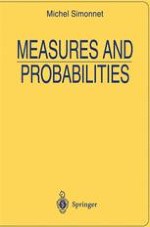1996 | OriginalPaper | Buchkapitel
The Strong Law of Large Numbers
verfasst von : Michel Simonnet
Erschienen in: Measures and Probabilities
Verlag: Springer New York
Enthalten in: Professional Book Archive
Aktivieren Sie unsere intelligente Suche, um passende Fachinhalte oder Patente zu finden.
Wählen Sie Textabschnitte aus um mit Künstlicher Intelligenz passenden Patente zu finden. powered by
Markieren Sie Textabschnitte, um KI-gestützt weitere passende Inhalte zu finden. powered by
15.1 This section gives some fundamental definitions in the theory of probability, such as the definitions of a probability space and a random variable.15.2 In this section the fundamental concept of independence is developed.15.3 We give an example of singular function, which arises naturally from probability theory.15.4 Given Ω, set Ω n = Ω for all n ∈ N and ΩN = Π n Ω n . The one-sided shift transformation v on ΩN is defined by (x n ) n ≥1 ↦ (x n +i) n ≥i. The probability of a v-invariant event is either 0 or 1 (Proposition 15.4.2) and v is μ-ergodic (Proposition 15.4.3)—see Section 11.4. Then, using Birkhoff’s ergodic theorem, we prove the strong law of large numbers (Theorem 15.4.1).15.5 A number x ≠ m/bn is said to be completely normal if, for every integer k and every k-tuple (u1,…, u k ) of base-b digits, the k-tuple appears in the base-b expansion of x with asymptotic relative frequency 1/bk. Almost every number (for Lebesgue measure) in [0, 1] is completely normal (Proposition 15.5.2).
